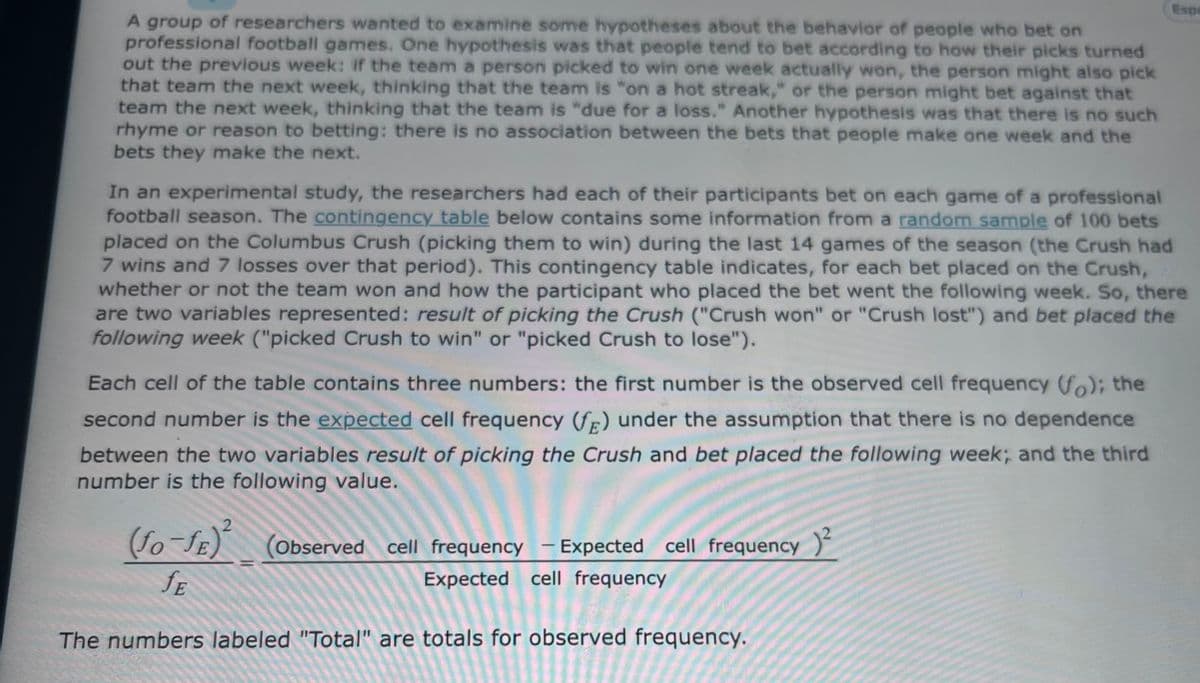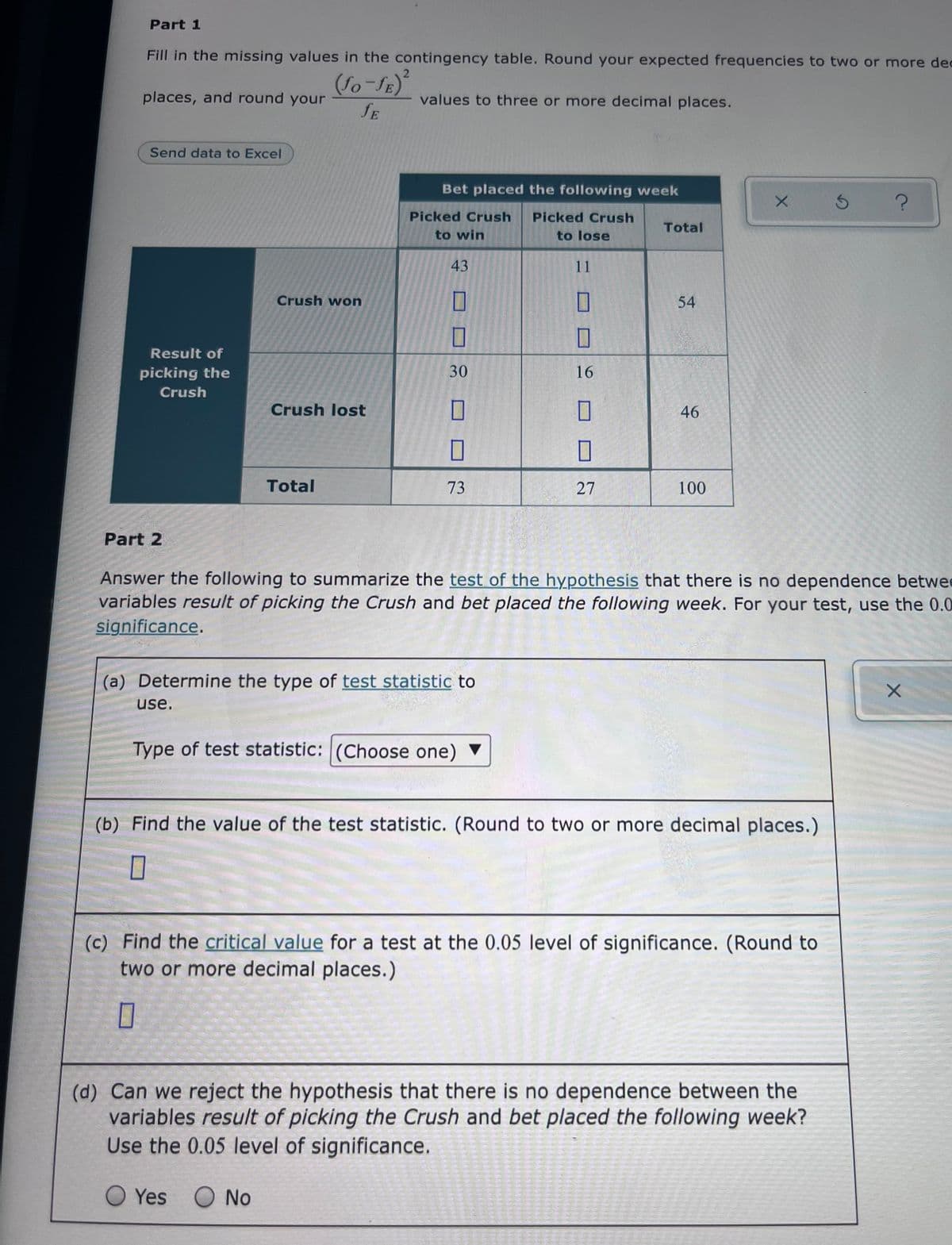Send data to Excel Bet placed the following week Picked Crush Picked Crush Total to win to lose 43 11 Crush won 54 Result of picking the 30 16 Crush Crush lost 46 Total 73 27 100 Part 2 Answer the following to summarize the test of the hypothesis that there is no dependence betwe variables result of picking the Crush and bet placed the following week. For your test, use the 0.0 significance. (a) Determine the type of test statistic to use. Type of test statistic: (Choose one) (b) Find the value of the test statistic. (Round to two or more decimal places.) (c) Find the critical value for a test at the 0.05 level of significance. (Round to two or more decimal places.) (d) Can we reject the hypothesis that there is no dependence between the variables result of picking the Crush and bet placed the following week? Use the 0.05 level of significance. O Yes O No
Send data to Excel Bet placed the following week Picked Crush Picked Crush Total to win to lose 43 11 Crush won 54 Result of picking the 30 16 Crush Crush lost 46 Total 73 27 100 Part 2 Answer the following to summarize the test of the hypothesis that there is no dependence betwe variables result of picking the Crush and bet placed the following week. For your test, use the 0.0 significance. (a) Determine the type of test statistic to use. Type of test statistic: (Choose one) (b) Find the value of the test statistic. (Round to two or more decimal places.) (c) Find the critical value for a test at the 0.05 level of significance. (Round to two or more decimal places.) (d) Can we reject the hypothesis that there is no dependence between the variables result of picking the Crush and bet placed the following week? Use the 0.05 level of significance. O Yes O No
MATLAB: An Introduction with Applications
6th Edition
ISBN:9781119256830
Author:Amos Gilat
Publisher:Amos Gilat
Chapter1: Starting With Matlab
Section: Chapter Questions
Problem 1P
Related questions
Question

Transcribed Image Text:Espa
A group of researchers wanted to examine some hypotheses about the behavior of people who bet on
professional football games. One hypothesis was that people tend to bet according to how their picks turned
out the previous week: if the team a person picked to win one week actually won, the person might also pick
that team the next week, thinking that the team is "on a hot streak," or the person might bet against that
team the next week, thinking that the team is "due for a loss." Another hypothesis was that there is no such
rhyme or reason to betting: there is no association between the bets that people make one week and the
bets they make the next.
In an experimental study, the researchers had each of their participants bet on each game of a professional
football season. The contingency table below contains some information from a random sample of 100 bets
placed on the Columbus Crush (picking them to win) during the last 14 games of the season (the Crush had
7 wins and 7 losses over that period). This contingency table indicates, for each bet placed on the Crush,
whether or not the team won and how the participant who placed the bet went the following week.. So, there
are two variables represented: result of picking the Crush ("Crush won" or "Crush lost") and bet placed the
following week ("picked Crush to win" or "picked Crush to lose").
Each cell of the table contains three numbers: the first number is the observed cell frequency (fo); the
second number is the expected cell frequency (fF) under the assumption that there is no dependence
between the two variables result of picking the Crush and bet placed the following week; and the third
number is the following value.
fo-fE) (Oobserved cell frequency - Expected cell frequency )
|
fE
Expected cell frequency
The numbers labeled "Total" are totals for observed frequency.

Transcribed Image Text:Part 1
Fill in the missing values in the contingency table. Round your expected frequencies to two or more dec
(So-fe)
places, and round your
values to three or more decimal places.
fE
Send data to Excel
Bet placed the following week
Picked Crush
Picked Crush
Total
to win
to lose
43
11
Crush won
54
Result of
picking the
30
16
Crush
Crush lost
46
Total
73
27
100
Part 2
Answer the following to summarize the test of the hypothesis that there is no dependence betwee
variables result of picking the Crush and bet placed the following week. For your test, use the 0.0
significance.
(a) Determine the type of test statistic to
use,
Type of test statistic: (Choose one) ▼
(b) Find the value of the test statistic. (Round to two or more decimal places.)
(c) Find the critical value for a test at the 0.05 level of significance. (Round to
two or more decimal places.)
(d) Can we reject the hypothesis that there is no dependence between the
variables result of picking the Crush and bet placed the following week?
Use the 0.05 level of significance.
O Yes O No
Expert Solution
This question has been solved!
Explore an expertly crafted, step-by-step solution for a thorough understanding of key concepts.
This is a popular solution!
Trending now
This is a popular solution!
Step by step
Solved in 2 steps

Recommended textbooks for you

MATLAB: An Introduction with Applications
Statistics
ISBN:
9781119256830
Author:
Amos Gilat
Publisher:
John Wiley & Sons Inc

Probability and Statistics for Engineering and th…
Statistics
ISBN:
9781305251809
Author:
Jay L. Devore
Publisher:
Cengage Learning

Statistics for The Behavioral Sciences (MindTap C…
Statistics
ISBN:
9781305504912
Author:
Frederick J Gravetter, Larry B. Wallnau
Publisher:
Cengage Learning

MATLAB: An Introduction with Applications
Statistics
ISBN:
9781119256830
Author:
Amos Gilat
Publisher:
John Wiley & Sons Inc

Probability and Statistics for Engineering and th…
Statistics
ISBN:
9781305251809
Author:
Jay L. Devore
Publisher:
Cengage Learning

Statistics for The Behavioral Sciences (MindTap C…
Statistics
ISBN:
9781305504912
Author:
Frederick J Gravetter, Larry B. Wallnau
Publisher:
Cengage Learning

Elementary Statistics: Picturing the World (7th E…
Statistics
ISBN:
9780134683416
Author:
Ron Larson, Betsy Farber
Publisher:
PEARSON

The Basic Practice of Statistics
Statistics
ISBN:
9781319042578
Author:
David S. Moore, William I. Notz, Michael A. Fligner
Publisher:
W. H. Freeman

Introduction to the Practice of Statistics
Statistics
ISBN:
9781319013387
Author:
David S. Moore, George P. McCabe, Bruce A. Craig
Publisher:
W. H. Freeman